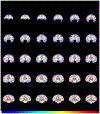Long-Term Cocaine Self-administration Produces Structural Brain Changes That Correlate With Altered Cognition
- PMID: 33012519
- PMCID: PMC7855373
- DOI: 10.1016/j.biopsych.2020.08.008
Long-Term Cocaine Self-administration Produces Structural Brain Changes That Correlate With Altered Cognition
Abstract
Background: An enduring question from cross-sectional clinical studies is whether the structural and functional differences often observed between cocaine users and healthy control subjects result from a history of drug use or instead reflect preexisting differences. To assess causality from drug exposure, true predrug baseline imaging and neurocognitive assessments are needed.
Methods: We addressed this fundamental question of causality using longitudinal anatomical magnetic resonance imaging and neurocognitive assessments in rhesus macaques. Cognitive tasks employed were stimulus reversal learning as a measure of cognitive flexibility/inhibitory control and delayed match to sample as a measure of visual working memory. Time points examined were before and following 12 months of chronic cocaine (n = 8) or water (n = 6) self-administration. A magnetic resonance imaging-only time point was also obtained following 2 years of forced abstinence.
Results: We identified localized patterns of gray matter density (GMD) changes that were largely concordant with cross-sectional clinical studies. These included decreases in orbitofrontal cortex, insula, amygdala, and temporal cortex. There was also a prominent increase in GMD in the caudate putamen. GMD decreases were significantly correlated with cognitive impairments across individuals only in select cortical regions. Following abstinence, changes in GMD in some regions, including the orbitofrontal cortex, insula, and amygdala, were persistent and thus may play an important role in risk of relapse following extended abstinence.
Conclusions: Cocaine use is causal in producing regional changes in GMD, and those changes appear to drive cognitive impairments.
Keywords: Addiction; Cocaine; Cognition; Impairment; Macaque; Structural imaging.
Published by Elsevier Inc.
Conflict of interest statement
Figures






Comment in
-
Brain Structural Consequences of Chronic Cocaine Exposure and Their Effects on Behavior.Biol Psychiatry. 2021 Feb 15;89(4):e11-e12. doi: 10.1016/j.biopsych.2020.12.002. Biol Psychiatry. 2021. PMID: 33478682 No abstract available.
References
-
- Ersche KD, Williams GB, Robbins TW, Bullmore ET (2013): Meta-analysis of structural brain abnormalities associated with stimulant drug dependence and neuroimaging of addiction vulnerability and resilience. Current opinion in neurobiology. 23:615–624. - PubMed
-
- Franklin TR, Acton PD, Maldjian JA, Gray JD, Croft JR, Dackis CA, et al. (2002): Decreased gray matter concentration in the insular, orbitofrontal, cingulate, and temporal cortices of cocaine patients. Biological psychiatry. 51:134–142. - PubMed
Publication types
MeSH terms
Substances
Grants and funding
LinkOut - more resources
Full Text Sources
Other Literature Sources
Medical

